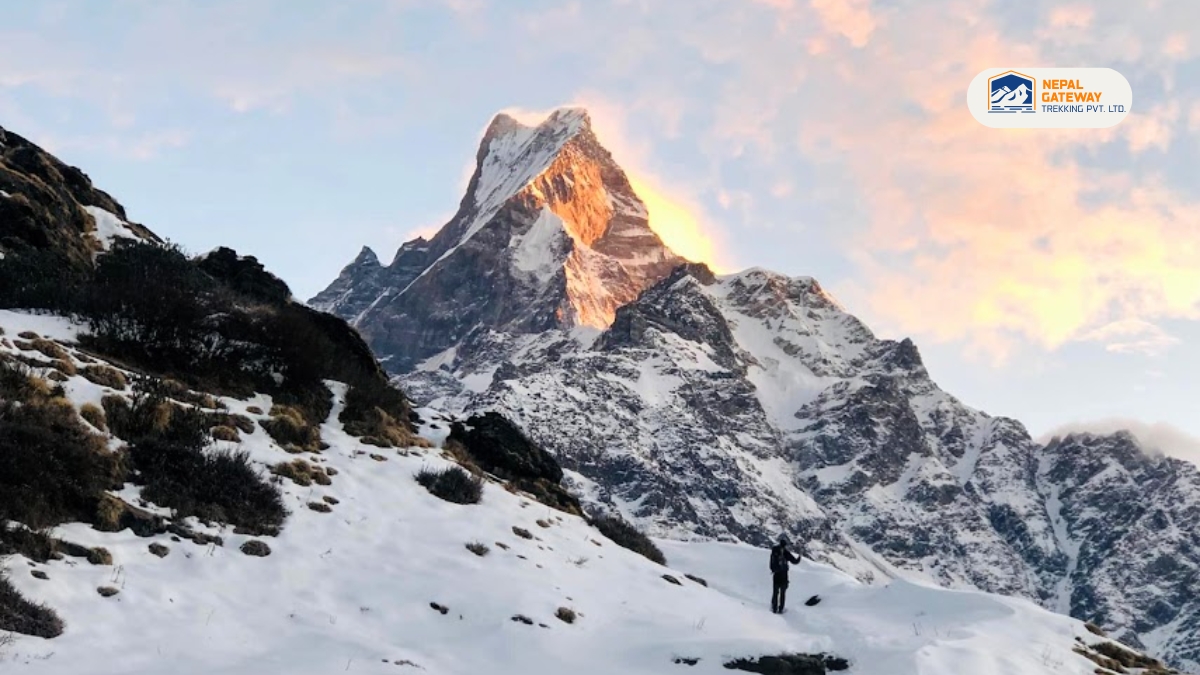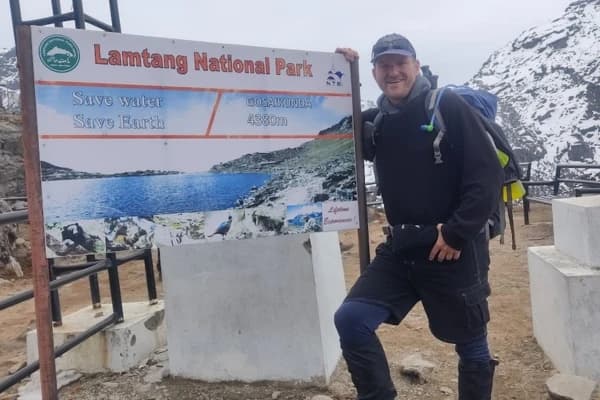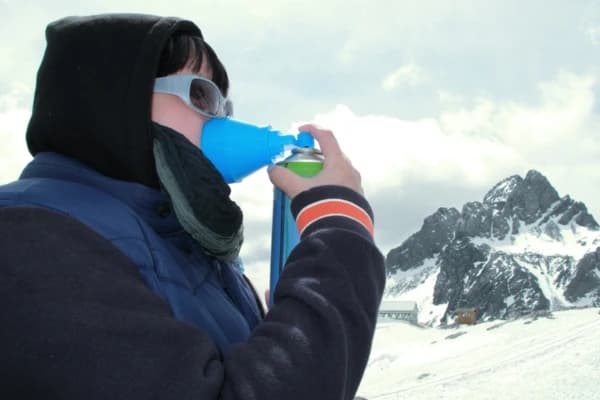Spring is the best time to do the Mardi Himal Trek, and once you’re out on the trail, you’ll quickly see why. This season is a favorite among both first-time and seasoned trekkers, thanks to the perfect combination of pleasant weather, vibrant landscapes, and crystal-clear mountain views.
As winter fades away, the trail comes alive with blooming rhododendrons—the national flower of Nepal—that paint the forests in stunning shades of red, pink, and white. Everything feels fresh and renewed: the air, the greenery, the mountains, and the very energy of the trail itself. This uplifting atmosphere is one of the reasons why spring is often called the best time to do the Mardi Himal Trek.
The weather during the day is comfortably warm, allowing most trekkers to hike in just a t-shirt or a light long-sleeved shirt. Nights can be chilly, especially at higher altitudes, but with the right layers and a good sleeping bag, it’s easy to stay cozy. The cool night air even helps many trekkers rest better after a full day of trekking.
Best of all, spring offers exceptional visibility, with clear skies that reveal breathtaking views of peaks like Machhapuchhre (Fishtail), Annapurna South, and Hiunchuli. If you’re looking to plan your trip precisely, checking the Mardi Himal Trek Weather by Month can help you understand the seasonal changes and prepare accordingly.
Suppose you’re wondering when the best time to do the Mardi Himal Trek is; spring offers a lively yet peaceful vibe. Trails are well maintained, teahouses are fully open, and you’ll meet fellow trekkers without the overcrowding found in peak seasons. It strikes a perfect balance between social energy and tranquil solitude.
7 Trip Highlights of the Mardi Himal Trek
The Mardi Himal Trek offers the perfect mix of gentle adventure, cultural richness, and scenic beauty. It can be a great choice for hikers looking for calm trails, unique community experiences, and breathtaking mountain views.
This trek offers something for everyone, regardless of your interests—be they culture, wildlife, or a solid physical challenge. If you're wondering when the Mardi Himal Trek is the finest time to do it, you'll find that it's suitable for all seasons due to its distinct appeal. The main highlights of this amazing journey are as follows:
- Stunning Mountain Views: Enjoy panoramic vistas of some of Nepal’s most iconic peaks, including Annapurna South, Machhapuchhre (Fishtail), Hiunchuli, and Mardi Himal Base Camp. The clear mountain scenery is perfect for photography and offers unforgettable memories for nature enthusiasts.
- Beautiful and Diverse Natural Scenery: Trek through colorful rhododendron forests, dense oak woodlands, and wide open alpine meadows. The trail features a rich diversity of landscapes with sweeping views of the Himalayas from high ridgelines.
- Peaceful and Less Crowded Trails: Mardi Himal is still comparatively uncrowded and less marketed than popular routes like the Annapurna Base Camp trek. Trekkers can take advantage of a more calm experience, perfect for people who want to establish a close relationship with nature.
- Authentic Village Life: Visit traditional Gurung villages and experience the warm hospitality of the local people. Learn about the local culture, customs, daily life, and people of the Himalayan foothills.
- Moderate Difficulty: Suitable for Most Trekkers. Well-suited for beginners or those with moderate trekking experience. Offers just the right amount of challenge to be physically rewarding without being too strenuous.
- Flexible Itinerary Options: The trek can be customized to accommodate various schedules, with options ranging from short 4-5 day treks to longer expeditions. This versatility makes it a good alternative for both short vacations and long-term trekking plans.
- Perfect for Nature Lovers and Adventurers: If you want a beautiful trek without big crowds, with great views, friendly people, and peaceful trails, the Mardi Himal Trek is a perfect choice!
Ready to experience the magic of the Mardi Himal Trek? Let Nepal Gateway Trekking be your trusted guide to an unforgettable Himalayan adventure.
When to Trek to Mardi Himal?

The Best Times to go to Mardi Himal are Spring and Autumn. These two seasons are the top choices for most trekkers—perfect weather, clear views, and excellent trekking conditions!
Choosing the right time makes your Mardi Himal trek even more special. Here’s when most trekkers consider the best time to do the Mardi Himal Trek and why these seasons stand out:
Mardi Himal Trek in Spring (March to May)
Best time for flowers! The rhododendron forests bloom with bright red and pink colors. Clear skies and warm weather make trekking easy and enjoyable—great mountain views with plenty of vibrant natural surroundings.
Mardi Himal Trek in Autumn (September to November)
The most popular season for trekking in Nepal. Cool, dry weather with clear blue skies. Amazing views of the Himalayas and golden forests.
Winter (December to February)
Cold but peaceful. Less crowded and quieter trails. Snowy mountains look extra beautiful, only for trekkers who don’t mind the cold and want a calm adventure.
Monsoon (June to August) - Considered not the best time to do the Mardi Himal Trek
Not the best time. Trails can be slippery and muddy. Clouds may block the mountain views. But the forests look fresh and green!
Main Trekking Seasons: Spring & Autumn
These periods are the best times to carry out the Mardi Himal Trek. The spring Mardi Himal Trek is especially popular, as the whole trekking route is bedecked with rhododendrons of every color, vegetation, and friendly temperatures.
Daytime temperatures are comfortable—usually warm enough for a trek in shirtsleeves—while evenings are chilly but manageable. Clear conditions dominate this time of year, offering spectacular vistas of famous peaks including Machhapuchhre (Fishtail), Annapurna South, and Hiunchuli.
Off-Seasons: Monsoon & Winter
Off-season trekking during monsoon months (June–August) and winter (December–February) comes with extra challenges of rain, slippery trails, and cold, snowy routes. It is also peace and solitude, greenery, thundering waterfalls, and jagged mountain scenery. Given the right gear and planning, it can be a very special experience for adventurous trekkers.
Are you excited to explore Nepal via different trekking routes? If yes, knowing the best time for trekking in Nepal is essential. Know all the essential details with Nepal Gateway Trekking.
Is Mardi Himal Trek Doable in the Off-Season?
Yes, you can do the Mardi Himal Trek in the off-season! However, if you choose to trek during these times, keep in mind that it might not be the best time to do the Mardi Himal Trek due to tougher weather conditions. Being well-prepared and flexible will help you enjoy the adventure despite the challenges.
Monsoon Season (June to August)
The trail is lush and green, with beautiful forests. You’ll see lots of waterfalls and fewer people—perfect for peace and quiet. The air feels fresh and alive.
However, Heavy rain can make the trail muddy and slippery. Leeches can be a problem in the lower forests. Clouds often block the mountain views. Landslides may occur on remote roads or trails.
Good for: Trekkers who love lush nature, don’t mind rain, and want a quiet trek.
Tips: Carry rain gear with essential things to pack for trek, waterproof boots, and leech socks. Start early in the day to avoid afternoon showers.
Winter Season (December to February)
Clear skies on sunny days—perfect for amazing mountain views. Very few trekkers enjoy the peace and quiet. The trail looks magical with snow-covered peaks.
However, very cold, especially at night, dropping below freezing. Snow may block higher parts of the trail. Shorter daylight hours.
Good for: Trekkers who are okay with cold weather and want peaceful surroundings.
If you’re a bit adventurous, have the right gear, and plan ahead, the off-season Mardi Himal trek can be a special, peaceful, and unique experience.
Tips: Wear warm layers, thermal gear, and good boots. Check the weather forecast and stay updated on snow conditions.
What can you expect during the monsoon season (June to August)?
During the monsoon season, from June to August, the Mardi Himal Trek gets hit with heavy rain, turning everything super green and alive. The trails can get pretty muddy and slippery, so it’s a bit trickier to trek, but the lush scenery makes it totally worth it.
You might not see the mountains clearly because of the clouds, but the peaceful vibe and fresh air make up for it. While the monsoon isn’t considered the best time to do the Mardi Himal Trek for clear mountain views, it offers a unique, tranquil experience for those who love quiet, nature-packed adventures.
Pros
- Very green, lush scenery with flowing waterfalls
- Fewer trekkers on the trail for solitude
- Discounts on trekking services and accommodations
Cons
- Heavy and frequent rainfall is making the trails slippery
- Increased risk of landslides and blocked roads
- Mountain views are often hidden by clouds
- Higher chance of leeches in the forested areas
You can get the latest Guidelines and Travel Tips from Nepal Tourism Board.
Final Thoughts
The best time for the Mardi Himal Trek is during the spring (March to May) and autumn (September to November) seasons. These periods offer clear skies, pleasant temperatures, and safer trail conditions, making your trekking experience more enjoyable and memorable. The best time to do the Mardi Himal Trek truly shines in these months when nature displays its full beauty and the trails are most accessible.
Off-season trekking (monsoon and winter) is doable, but it necessitates careful planning, appropriate equipment, and a willingness to confront problems such as rain, cold, and limited facilities. Even during these seasons, the optimal time to complete the Mardi Himal Trek can be adjusted to individuals looking for quiet and distinctive scenery.
Ready to experience the best time to do the Mardi Himal Trek? Contact Nepal Gateway Trekking today and start planning your unforgettable Himalayan adventure!
Mardi Himal Trek FAQs — Simple Answers for Trekkers
When is the best time for trekkers to do the Mardi Himal Trek?
The best time for trekkers to do the Mardi Himal Trek is during spring (March to May) and autumn (September to November), thanks to clear skies and moderate temperatures. These seasons provide the safest trails and breathtaking mountain views.
Can trekkers do the Mardi Himal Trek during the monsoon season?
Yes, trekkers can trek during the monsoon (June to August), but should be prepared for slippery trails and possible landslides. The lush green landscapes and fewer crowds make it a rewarding experience for those ready for the challenges.
Is trekking Mardi Himal safe for trekkers in winter?
Winter trekking (December to February) is safe for trekkers who have proper cold-weather gear and preparation. Snow may be present on trails, but clear skies offer stunning Himalayan views.
Do trekkers need permits for the Mardi Himal Trek?
Yes, trekkers must have a TIMS card and an Annapurna Conservation Area Permit (ACAP). These permits help conservation efforts and can be obtained before the trek in Kathmandu or Pokhara.
How long does the Mardi Himal Trek usually take for trekkers?
Trekkers typically complete the trek in 5 to 7 days, depending on their pace and acclimatisation needs. Weather and side trips can also affect the duration.
Is hiring a guide necessary for trekkers on the Mardi Himal Trek?
While not mandatory, hiring a guide is highly recommended for trekkers for safety and local knowledge. Guides also enrich the trekking experience by helping navigate the trail.
Are lodges open year-round for trekkers on the Mardi Himal Trek?
Most lodges stay open year-round, but some may close or reduce services during the off-season. Trekkers should check lodge availability when trekking during monsoon or winter.
What clothing should trekkers pack for the Mardi Himal Trek?
Trekkers should pack layered clothing, including waterproof jackets, warm mid-layers, and thermal base layers to stay comfortable and protected against changing weather.
Is the Mardi Himal Trek suitable for beginner trekkers?
Yes, the trek is suitable for beginner trekkers with moderate fitness and proper acclimatisation. The trail is well-marked and manageable for most newcomers.
What else should trekkers prepare before starting the Mardi Himal Trek?
Trekkers should ensure they have all necessary permits, suitable gear, and possibly travel insurance. Flexibility with schedules is important to manage weather or trail changes.





